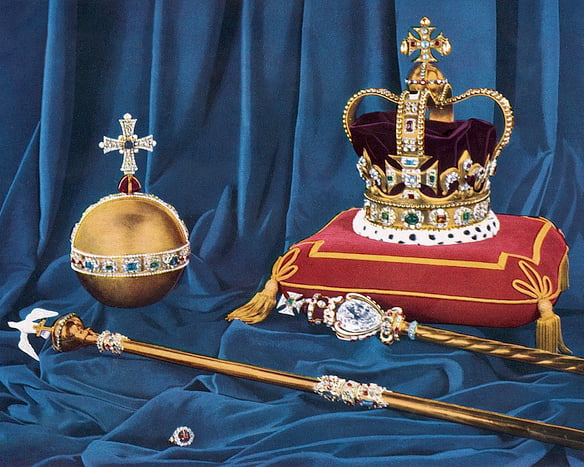
This event, on 2 June 1953, came after a long and drab period of post-war austerity, and was hailed as the beginning of a new Elizabethan age, personified by a sovereign who was a young mother of two small children, and whose husband was a handsome naval officer.
The decision was made early on to follow the pattern of George VI’s 1937 coronation. The Coronation Committee was chaired by the Duke of Edinburgh, the Queen’s husband, and included senior members of the Cabinet, the Earl Marshal, senior members of the Royal Household and the Archbishop of Canterbury. More detailed planning was undertaken by the Coronation Executive Committee, chaired by the Earl Marshal, which included six Commonwealth High Commissioners – this was seen as a way of involving Commonwealth countries in the accession process.
Norman Hartnell was commissioned to design the outfits for all members of the Royal Family. The Queen’s embroidered white satin gown used subtle shades of pink, blue, yellow, and green to incorporate the emblems of Britain and the Commonwealth into the design: the Tudor Rose, the thistle, leek, shamrock, the Canadian maple leaf, the Australian wattle flower, the fern of New Zealand, the protea of South Africa, the wheat and jute of Pakistan and the lotus of Ceylon. Made of Lullingstone silk, it was worked by six embroideresses in the utmost secrecy.
Six maids of honour attended Elizabeth throughout the coronation, and were responsible for carrying her train. The Mistress of the Robes, the Dowager Duchess of Devonshire, prepared the Queen for her anointing. The maids of honour wore Hartnell-designed dresses of white satin with a gold motif.
The ceremony itself closely followed the 1937 ritual, and took place within the Anglican service of communion – effectively excluding other Christian priests, or other religions.
The Queen walked down the aisle to the strains of Parry’s ‘I was glad’, and shouts of ‘Vivat Regina’. The ensuing ceremony remained fundamentally unchanged over the last thousand years; the first English monarch to be crowned in the Abbey was William the Conqueror in 1066. It is steeped in symbolism, pageantry and a religious sense of awe. It brought together not only the monarch but the senior religious leaders and the scions of the nobility.
The core of the ceremony, performed by the Archbishop of Canterbury, was the recognition of the sovereign by the assembled congregation, the administration of the coronation oath, the anointing with holy oil (the secret recipe contains oils of orange flowers, roses, jasmine, cinnamon, musk, civet and ambergris), the investiture with the Royal regalia and the actual crowning. These key moments in the historic service were punctuated with trumpet fanfares and shouts of ‘God save the Queen’, and the robing in ritual garments – a simple white overdress, the golden super-tunic and the Dalmatic robe, which represents righteousness.
The St Edward’s Crown, made for the coronation of Charles II, was placed on the Queen’s head at 12.34 pm, and the acclamation of the congregation was matched by the firing of canon salutes from the Tower of London. Elizabeth exited the Abbey at 2.53 pm, wearing the Imperial state crown.
Some 44,178 servicemen were involved in the ceremonies. Because of the distances and logistical problems otherwise involved in bussing troops into London many of them were accommodated in Earls Court Olympia and Clapham Deep Shelter. Some 17,000 troops were encamped in Kensington Gardens.
The route to the Abbey was 1 mile 770 yards (2,313 m) and the longer procession from the Abbey covered 5 miles and 250 yards (8,275 m). Nearly 16,000 servicemen and twenty military bands lined the route, while 24 military bands marched in the processions themselves.
The procession routes offered a great range of viewing opportunities for members of the public, and public stands were erected outside the Abbey, along Whitehall, the Mall and Hyde Park. It is estimated that 3 million people lined the ceremonial route on Coronation Day. From very early in the morning they were able to observe a parade of cloaked peers, peeresses in evening dress, and foreign royalty in an array of national costumes.
When the ceremony in Westminster Abbey was finished, the newly crowned Queen was paraded through the streets of London. On the route back from Westminster Abbey to Buckingham Palace 40,000 British, Commonwealth and Colonial troops and related services marched twelve abreast. The UK Prime Minster, Winston Churchill, was the senior of the ten Commonwealth Prime Ministers in open carriages. Churchill was escorted by a mounted detachment of his old regiment, the 4th Hussars. The Queen was escorted by the Household Brigade, senior members of her Household, service ADCs, and senior service officers from the UK and Commonwealth forces. The procession was so long that it took forty-five minutes to pass any stationary point.
Six hours and 20 minutes after she had set out, the Queen returned to Buckingham Palace. She appeared on the balcony, to ecstatic shouts from the crowds, wearing the magnificent Imperial State Crown. The RAF marked the occasion with a fly past down the Mall and Victoria Embankment was lit up with a magnificent

Wearing her coronation robes, the Queen arrives at Parliament House in Canberra in 1954. The Queen displayed her magnificent coronation robes on Commonwealth tours in the year following the Coronation.
Although post-war rationing was still in force, Churchill insisted that an extra £1 of sugar should be made available to everybody. Rationing restrictions were lifted from eggs and sweets.
Even applications to roast a whole ox, a traditional coronation celebration, were allowed under certain circumstances. Street parties, which first evolved at the end of the First World War, were held all over the country, as well as village fêtes, bonfires and services of commemoration. Constance Spry devised a special dish, Coronation Chicken, for the coronation lunch for 350 foreign guests, and this reminder of the big day has remained enduringly popular. The government spent over £2 million on the celebrations.
Looks like you haven't made a choice yet.